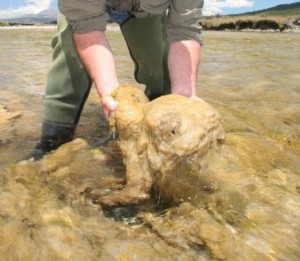Didymo Information
Didymo: The Story So Far
Since didymo, or rock snot, was first discovered in the Lower Waiau River of Southland in 2004. It has spread rapidly and is now present in over 150 lakes, rivers and streams throughout the South Island. The freshwater algae forms unsightly mats affecting fish prey species and makes recreational activities unpleasant.
The species began expanding outside of its native range in North America and Europe in the mid-1980s forming nuisance blooms in places. This trend has continued with a second Southern Hemisphere incursion being confirmed in Patagonia, Chile in April 2010.
To date, the social marketing campaign led by MAF Biosecurity New Zealand has been successful in restricting the infestation to the South Island. From 2004 to 2011 the economic impact to New Zealand has been estimated in the range of $58 to $285 million.
Check Clean Dry
The ‘Check, Clean, Dry’ message being promoted by MAF Biosecurity, Regional Councils, the Department of Conservation and Fish and Game encourages all waterway users to ‘Check’ for any clumps on gear before leaving a waterway, ‘Clean’ gear with an approved cleaning solution or, if cleaning is not possible, items must be ‘Dry’ for at least 48 hours to ensure that didymo is not spread between waterways. It is equally important for all waterway users from anglers to trampers to follow these procedures. If kept moist, didymo cells can remain viable for months after leaving a waterway. Felt-soled waders are highly absorbent and laboratory tests have shown that it is very difficult to kill all cells within the felt. For this reason felt-soled waders are not permitted for freshwater fishing in New Zealand.
This message is also being promoted to prevent the spread of other freshwater pests already present in the North Island. These include lagarosiphon, hornwort and hydrilla, one of the world’s worst aquatic weeds which is currently being controlled with grass carp in three Hawke’s Bay lakes.
Research & Mapping
Studies conducted by New Zealand scientists have made them world leaders in didymo research. New DNA detection systems developed by the University of Waikato allow scientists to detect very small numbers of didymo cells in vast quantities of water. Based on the characteristics of infested waterways, NIWA have produced Didymo Predictive Maps
which can be used to predict the extent to which New Zealand rivers are susceptible to a didymo infestation.

